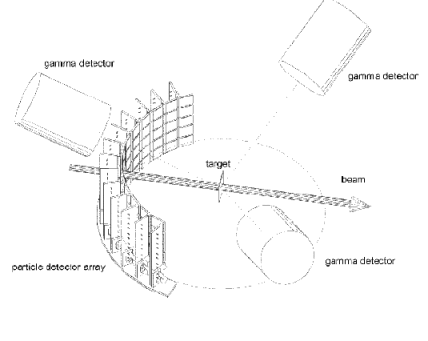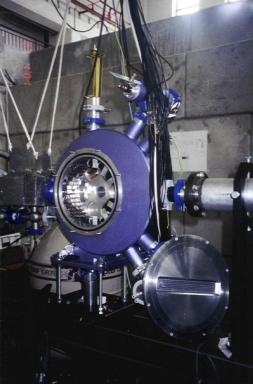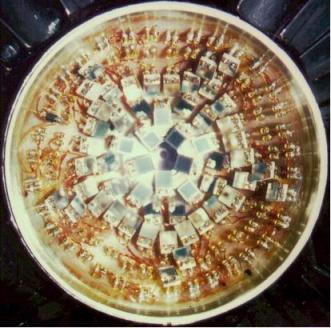Other experimental set-ups: IGISOL JANOSIK CUP Si Detectors BARRIERS SYRENA ICARE EAGLE
COULOMB EXCITATION
AT THE WARSAW CYCLOTRON
the Warsaw Coulex Group:
Paweł Napiorkowski, Katarzyna Hadyńska-Klęk,
Jędrzej Iwanicki, Michalina Komorowska, Julian Srebrny, Kasia
Wrzosek-Lipska
The Warsaw Coulex Group was gathered in the early nineties around
Tomek Czosnyka, who was its leader until his death in 2006.
Under his supervision three PhD and two MSc theses were completed, all
applying the Coulomb excitation method to nuclear structure studies.
Coulomb excitation method
Coulomb excitation (Coulex) is
a powerful method to study nuclear structure. Proper selection of
the beam energy assures that the interaction between the colliding
beam and target particles is purely electromagnetic, thus allowing
for the model-independent description in terms of classical
electrodynamics, free from assumptions concerning the nuclear
forces. The use of various beams and covering broad ranges of scattering
angles makes it possible to measure full sets of the
parameters of the electromagnetic structure up to high-spin levels
- transitional matrix elements and static moments, which
are related to spectroscopic observables such as lifetimes, gamma-ray intensities,
branching and mixing ratios. Finally, the knowledge of a full
set of matrix elements can be used to determine the shape of the
nucleus for each excited level independently, thus serving as
"nuclear microscope". Heavy ion Coulex provides a
stringent test of existing models in a purely experimental way.
Recently new interest in Coulexhas been drawn by
commissioning of the radioactive beam facilities that open perspectives to study the structure of unstable nuclei.
Heavy Ion Laboratory is capable of performing
full-scale Coulex projects. The
U-200P cyclotron offers a wide range of heavy ion beams and the
flexibility of adjusting the beam energy according to the
requirements.
Coulex setups at HIL
Two particle detector arrays designed for Coulomb excitation
studies are used at HIL. The older setup, CUDAC (Coulomb Universal Detector Array
Chamber)
was constructed in the Laboratory in the early nineties
and installed as one of the permanent experimental stands.
After some years of succesful CUDAC measurements, a new scattering chamber, previously used with the NORDBALL setup,
was adapted to work with the gamma detector array
EAGLE
Both setups were built on the same principle. Coincident
detection of gamma radiation and scattered particles makes possible to
uniquely and precisely
ascribe the observed gamma rays to the kinematics of collision.
This in turn enhances the efficiency of experiments - one physical
accelerator run can be off-line divided into several data sets
differing by impact parameter. Such an operation is
equivalent to performing several experiments at the same real time.
In both scattering chambers small silicon detectors,
so-called PIN-diodes, are used for particle detection. As
PIN-diodes are not position-sensitive, the information on particle
detection angle is obtained by using many diodes in one setup. The
relatively small area of a single detector provides sufficiently precise
information on scattering angle.
The particle energy measurement is not essential in Coulomb
excitation
experiments. With thin targets the information on the particle scattering
angle
is sufficient to determine the whole kinematics of the scattering process. However, the
information on the particle energy is useful to reject the events caused by
noise or scattering on admixtures in target. It is also crucial when
analysing
experiments with thick targets when the incident energy changes due
to the beam stopping in target.
CUDAC
The CUDAC chamber is equipped with 32
PIN-diodes (1 x 1cm), placed at backward angles, which correspond to the
strongest excitation of the investigated nucleus.
To detect the deexcitation γ-radiation in Coulex
studies three HPGe
detectors were used, working in coincidence with PIN-diodes.
 |
 |
| Fig. 1, left: Schematic view of the CUDAC set-up. |
right:
The CUDAC chamber open to show the silicon detectors
inside. |
CUDAC has proven to be an excellent tool to study the
properties of well deformed nuclei, such as 165Ho. However, for the less
deformed ones, such as Mo isotopes, the gamma detection efficiency was too low
and therefore we decided to use a more compact Coulex scattering chamber with a
multi-detector germanium array OSIRIS-II.
Nowadays CUDAC is used for experiments other than
Coulomb excitation, mostly fusion barrier studies.
The data collected using the CUDAC setup were a basis for
3 PhD theses
(two on Coulomb excitation: J. Iwanicki (2002), M. Zielińska (2006) and one
on fusion barrier distributions: Ł. Świderski (2005)) as well as for several
MSc theses.
New scattering chamber
The scattering chamber, which was succesfully
integrated into OSIRIS-II
and then EAGLE,
had been constructed at LMU Munich as a dedicated
Coulomb excitation setup designed for use with the NORDBALL germanium array.
Its small size (10cm in diameter) allows to place
HPGe detectors at close distances from the target, thus increasing gamma
detection efficiency. The chamber can accomodate up to 110 PIN-diodes of 0.5 x 0.5cm active
area, covering the backward angles (from 110 to 170 degrees with respect to
the beam direction). At present 48 PIN-diodes are used.
The original electronics was replaced by three 16-fold
digitally controlled fast/slow amplifiers (CAEN N568/LC) and constant
fraction discriminators (CAEN C808).
The first experiment using this new dedicated Coulex setup was performed in
2006. All Coulex experiments at HIL performed after this date could
benefit from higher overall efficiency and improved peak-to-Compton ratio of the
OSIRIS-II array (comprising 12 BGO-shielded HPGe detectors) and its
successor EAGLE.
 |
| Fig. 2:The backward hemisphere of the new scattering chamber.
|
Data analysis
Last but not least, HIL Coulex team
is in command of the sophisticated software necessary to analyze
the wealth of data from the experiments. This includes both
processing of "raw" data and further extraction of electromagnetic
matrix elements from measured gamma-ray intensities.
The analysis computer codes,
GOSIA and SIGMA, developed,
maintained and updated by Warsaw Coulex group members, are now
used by numerous world laboratories dealing with Coulomb
excitation. A list of collaborating centers include Rochester and
Argonne (USA), Saclay and Orsay (France), Leuven (Belgium), Liverpool (UK), Jyvaskyla (Finland),
Muenchen (Germany), Chandigarh (India), Tokai, Chiba, Osaka and
Kyushu (Japan).
It should be stressed that
available data from heavy ion Coulex are still scarce, so
our Coulex project has obviously wide perspectives for the future. It
already is and should remain for the years to come one of the home
specialties of the nuclear physics in Warsaw.
Other experimental set-ups: IGISOL JANOSIK CUP Si Detectors BARRIERS SYRENA ICARE EAGLE | 






















